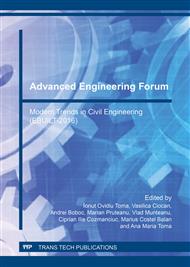[1]
S. Ziyad, Renewable Energy System Design, Academic Press, Waltham, Massachusetts, USA, Chapter 4, pp.201-29 (2014).
Google Scholar
[2]
I.S. Ike, S. Iyuke, Mathematical Modelling and Simulation of Supercapacitors, Nanomaterials in Advanced Batteries and Supercapacitors, Nanostructure Science and Technology, pp.515-562.
DOI: 10.1007/978-3-319-26082-2_15
Google Scholar
[3]
P. Rajput, G.N. Tiwari, O.S. Sastry, B. Bora, V. Sharma, Degradation of mono-crystalline photovoltaic modules after 22 years of outdoor exposure in the composite climate of India, Solar Energy 135 (2016) 786–795.
DOI: 10.1016/j.solener.2016.06.047
Google Scholar
[4]
H. El Brouji, O. Briat, J.M. Vinassa, N. Bertrand, E. Woirgard, Comparison between changes of ultracapacitors model parameters during calendar life and power cycling ageing tests, Microelectronics Reliability 48 (2008) 1473–1478.
DOI: 10.1016/j.microrel.2008.07.022
Google Scholar
[5]
R. German, A. Sari, P. Venet, M. Ayadi, O. Briat, J.M. Vinassa, Prediction of supercapacitors floating ageing with surface electrode interface based ageing law, Microelectronics Reliability 54 (2014) 1813–1817.
DOI: 10.1016/j.microrel.2014.07.105
Google Scholar
[6]
P.O. Logerais, O. Riou, M.A. Camara, J.F. Durastanti (2013).
Google Scholar
[7]
A. Djellad, P.O. Logerais, A. Omeiri, O. Riou, J.F. Durastanti (2014), Optimization of the energy transfer in a system combining photovoltaic source to ultracapacitors, International Journal of Hydrogen Energy, 39(27), p.15169–15177.
DOI: 10.1016/j.ijhydene.2014.03.144
Google Scholar
[8]
R. Doumane, M. Balistrou, P. O. Logerais, O. Riou, J. F. Durastanti, A. Charki, A Circuit-Based Approach to Simulate the Characteristics of a Silicon Photovoltaic Module With Aging, Journal of Solar Energy Engineering 137(2), 021020.
DOI: 10.1115/1.4029541
Google Scholar
[9]
M.G. Villalva, J.R. Gazoli, F.E., Ruppert, Modelling and circuit-based simulation of photovoltaic array, Brazilian Journal Of Power Electronics 14(1), 200935-45.
Google Scholar
[10]
D. L. King, M. A. Quintana, J. A. Kratochvil, D. E. Ellibee, B. R. Hansen, (2000), Photovoltaic Module Performance and Durability Following Long-term Field Exposure, Progress in photovoltaics: research and applications, 8, pp.241-256.
DOI: 10.1002/(sici)1099-159x(200003/04)8:2<241::aid-pip290>3.0.co;2-d
Google Scholar
[11]
H.Y. Hsu, H.H. Hsieh, H.Y. Tuan, J.L. Hwang, (2010), Oxidized low density polyethylene: A potential cost-effective, stable, and recyclable polymeric encapsulant for photovoltaic modules, Solar Energy Materials & Solar Cells, 94, p.955–959.
DOI: 10.1016/j.solmat.2010.01.020
Google Scholar
[12]
N. Park, C. Han, D. Kim, (2013), Effect of moisture condensation on long-term reliability of crystalline silicon photovoltaic modules, Microelectronics Reliability 53 (2013) 1922-(1926).
DOI: 10.1016/j.microrel.2013.05.004
Google Scholar
[13]
T. Hulkoff, Usage of Highly Accelerated Stress Test (HAST) in Solar Module Ageing Procedures. Master of Science Thesis, Chalmers University of Technology, Göteborg, Sweden, (2009).
Google Scholar
[14]
Standard IEC 61215, Crystalline silicon terrestrial photovoltaic (PV) modules – Design qualification and type approval.
DOI: 10.3403/00583064
Google Scholar
[15]
F. Belhachemi, Modélisation et caractérisation des supercondensateurs à couche double électrique utilisés en électronique de puissance, thèse de doctorat, Institut National Polytechnique de Lorraine, (2001).
DOI: 10.3166/rige.8.633-657
Google Scholar
[16]
B. Multon, J. Aubry, P. Haessig, H. Ben Ahmed, Systèmes de stockage d'énergie électrique, Techniques de l'Ingénieur, (2013).
DOI: 10.51257/a-v1-be8100
Google Scholar


